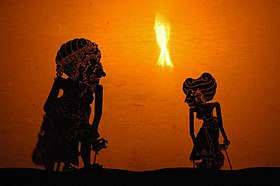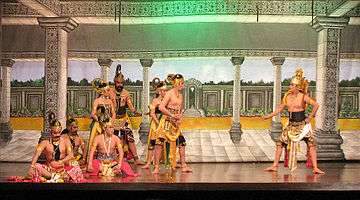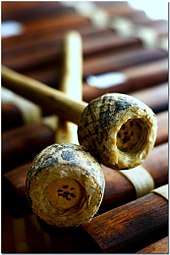Wayang
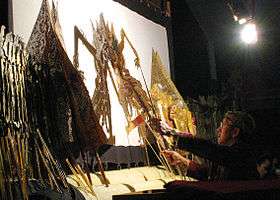
Wayang (Krama Javanese: Ringgit ꦫꦶꦁꦒꦶꦠ꧀, "Shadow"), also known as Wajang, is a form of puppet theatre art found in Indonesia and other parts of Southeast Asia,[1] wherein a dramatic story is told through shadows thrown by puppets and sometimes combined with human characters.[2][3] The art form celebrates the Indonesian culture and artistic talent; its origins are traced to the spread of Hinduism in the medieval era and the arrival of leather-based puppet arts called Tholu bommalata from southern India.[2][4][5]
Wayang refers to the entire dramatic show. Sometimes the leather puppet itself is referred to as wayang.[6] Performances of shadow puppet theatre are accompanied by a gamelan orchestra in Java, and by gender wayang in Bali. The dramatic stories depict mythologies, such as episodes from the Hindu epics the Ramayana, the Mahabharata as well as local adaptations of cultural legends.[2][3][5] Traditionally, a wayang is played out in a ritualized midnight-to-dawn show by a dalang, an artist and spiritual leader; people watch the show from both sides of the screen.[2][3]
UNESCO designated wayang kulit, a shadow puppet theatre and the best known of the Indonesian wayang, as a Masterpiece of Oral and Intangible Heritage of Humanity on 7 November 2003. In return for the acknowledgment, UNESCO required Indonesians to preserve their heritage.[7] Wayang has also been a significant historical art form in Malaysia, Thailand, Cambodia and Laos.[1][8][note 1]
Etymology
The term 'wayang' is the Javanese word for shadow,[11] or bayang in standard Indonesian; the word also means "imagination". In modern daily Javanese and Indonesian vocabulary, wayang can refer to the puppet itself or the whole puppet theatre performance.
History

Wayang is the traditional shadow puppet theatre in Indonesia and other southeast Asian countries.[1][2][3] There is no evidence that wayang existed in ancient Indonesia. The earliest evidence is from the late 1st millennium CE, in medieval-era texts and archeological sites. The origins of Wayang are unclear, and three competing theories have been proposed:[12]
- Indian origin: this is the generally favored theory, since Hinduism and Buddhism arrived on the Indonesian islands in the early centuries of the 1st millennium, and along with theology, the peoples of Indonesia and Indian subcontinent exchanged culture, architecture and traded goods.[12][4][5] Puppet arts and dramatic plays have been documented in ancient Indian texts, dated to the last centuries of the 1st millennium BCE and the early centuries of the common era.[13] Further, the coastal region of Southern India (Andhra Pradesh and Tamil Nadu) which most interacted with Indonesian islands has had a leather-based intricate puppet arts called Tholu bommalata, which shares many elements with Wayang.[2][14] Some characters such as the Vidusaka in Sanskrit drama and Semar in Wayang are very similar. Indian mythologies and characters from the Hindu epics feature in many of the major plays performed, all of which suggest possible Indian origins, or at least an influence in the pre-Islamic period of Indonesian history.[12] Jivan Pani states that wayang developed from two arts of Odisha in Eastern India, the Ravana Chhaya puppet theatre and the Chhau dance.[15]
- Indigenous origin: the word "Wayang" is not found in Indian languages, but is Javanese. Similarly, some of the other technical terms used in the Wayang Kulit found in Java and Bali are based on local languages, even when the play overlaps with Buddhist or Hindu mythologies. This suggests, state some scholars such as Hazeu, that Wayang has indigenous roots.[12]
- Chinese origin: the least popular theory, but it is based on the evidence that puppet arts based on animism existed in ancient China (1000CE) and it may have been the "place of origin of all Asian shadow theatre", states Brandon.[12]
Regardless of its origins, states Brandon, Wayang developed and matured into a Javanese phenomenon. There is no true contemporary puppet shadow artwork in either China or India that has the sophistication, depth and creativity as expressed in Wayang.[12]
Development
The oldest known record that probably concerns wayang is from the 9th century. Around 860 CE an Old Javanese (Kawi) charter issued by Maharaja Sri Lokapala mentions three sorts of performers: atapukan, aringgit, and abanol. Ringgit is described in an 11th-century Javanese poem as a leather shadow figure. An inscription dated 930 CE says si Galigi mawayang ("Sir Galigi played wayang"). From that time till today it seems certain features of traditional puppet theatre have remained. Galigi was an itinerant performer who was requested to perform for a special royal occasion. At that event he performed a story about the hero Bhima from the Mahabharata. The kakawin Arjunawiwaha composed by Mpu Kanwa, the poet of Airlangga's court of Kahuripan kingdom, in 1035 CE describes santoṣâhĕlĕtan kĕlir sira sakêng sang hyang Jagatkāraṇa, which means "He is steadfast and just a wayang screen away from the 'Mover of the World'." Kelir is Javanese word for wayang screen, the verse eloquently comparing actual life to a wayang performance where the almighty Jagatkāraṇa (the mover of the world) as the ultimate dalang (puppet master) is just a thin screen away from us mortals. This reference to wayang as shadow plays suggested that wayang performance is already familiar in Airlangga's court and wayang tradition has been established in Java, perhaps earlier. An inscription from this period also mentioned some occupations as awayang and aringgit.[16]
Wayang kulit is a unique form of theatre employing light and shadow. The puppets are crafted from buffalo hide and mounted on bamboo sticks. When held up behind a piece of white cloth, with an electric bulb or an oil lamp as the light source, shadows are cast on the screen. The plays are typically based on romantic tales and religious legends, especially adaptations of the classic Indian epics, the Mahabharata and the Ramayana. Some of the plays are also based on local happening or other local secular stories.
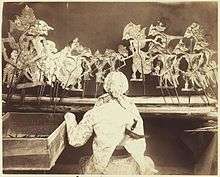
Artist
The dalang, sometimes referred to as Dhalang or Kawi Dalang, is the puppeteer artist behind the entire performance.[2][3][17] It is he who sits behind the screen, sings and narrates the dialogues of different characters of the story.[18] With a traditional orchestra in the background to provide a resonant melody and its conventional rhythm, the dalang modulates his voice to create suspense thus heightening the drama. Invariably, the play climaxes with the triumph of good over evil. The dalang is highly respected in Indonesian culture for his knowledge, art and as a spiritual person capable of bringing to life the spiritual stories in the religious epics.[2][3][18]
The figures of the wayang are also present in the paintings of that time, for example, the roof murals of the courtroom in Klungkung, Bali. They are still present in traditional Balinese painting today. The figures are painted, flat woodcarvings (a maximum of 5 to 15 mm thick—barely half an inch) with movable arms. The head is solidly attached to the body. Wayang klitik can be used to perform puppet plays either during the day or at night. This type of wayang is relatively rare.
Wayang today is both the most ancient and most popular form of puppet theatre in the world. Hundreds of people will stay up all night long to watch the superstar performers, dalang, who command extravagant fees and are international celebrities. Some of the most famous dalang in recent history are Ki Nartosabdho, Ki Anom Suroto, Ki Asep Sunandar Sunarya, Ki Sugino, and Ki Manteb Sudarsono.
Styles
Wayang kulit
_from_central_Java%2C_a_scene_from_'Irawan's_Wedding'.jpg)
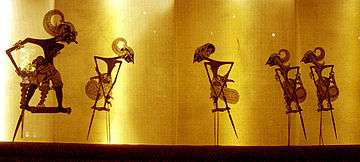
Wayang kulit, or shadow puppets, are without a doubt the best known of the Indonesian wayang. Kulit means skin, and refers to the leather construction of the puppets that are carefully chiselled with very fine tools, supported with carefully shaped buffalo horn handles and control rods, and painted in beautiful hues, including gold. The stories are usually drawn from the Hindu epics the Ramayana and the Mahabharata.[19].
There is a family of characters in Javanese wayang called Punakawan; they are sometimes referred to as "clown-servants" because they normally are associated with the story's hero, and provide humorous and philosophical interludes. Semar is actually the god of love, who has consented to live on earth to help humans. He has three sons: Gareng (oldest ), Petruk, and Bagong (youngest son). These characters did not originate in the Hindu epics, but were added later.[20] They provide something akin to a political cabaret, dealing with gossip and contemporary affairs.
The puppet figures themselves vary from place to place. In Central Java the city of Surakarta (Solo) and city of Yogyakarta have the most well-known wayang traditions, and the most commonly imitated style of puppets. Regional styles of shadow puppets can also be found in Temanggung, West Java, Banyumas, Cirebon, Semarang, and East Java. Bali wayang are more compact and naturalistic figures, and Lombok has figures representing real people. Often modern-world objects as bicycles, automobiles, airplanes and ships will be added for comic effect, but for the most part the traditional puppet designs have changed little in the last 300 years.
Historically, the performance consisted of shadows cast by an oil lamp onto a cotton screen. Today, the source of light used in wayang performance in Java is most often a halogen electric light, while Bali still uses the traditional firelight. Some modern forms of wayang such as Wayang Sandosa (from BahaSA iNDOneSiA, since it uses the national language of Indonesian instead of Javanese) created in the Art Academy at Surakarta (STSI) employs theatrical spotlights, colored lights, contemporary music, and other innovations.
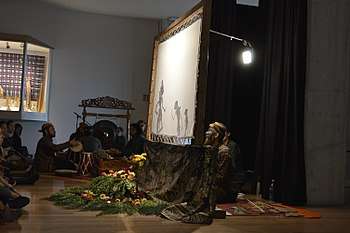
Making a wayang kulit figure that is suitable for a performance involves hand work that takes several weeks, with the artists working together in groups. They start from master models (typically on paper) which are traced out onto skin or parchment, providing the figures with an outline and with indications of any holes that will need to be cut (such as for the mouth or eyes). The figures are then smoothed, usually with a glass bottle, and primed. The structure is inspected and eventually the details are worked through. A further smoothing follows before individual painting, which is undertaken by yet another craftsman. Finally, the movable parts (upper arms, lower arms with hands and the associated sticks for manipulation) mounted on the body, which has a central staff by which it is held. A crew makes up to ten figures at a time, typically completing that number over the course of a week. However, unfortunately there is not strong continuing demand for the top skills of wayang craftspersons and the relatively few experts still skilled at the art sometimes find it difficult to earn a satisfactory income.[22]
The painting of less expensive puppets is handled expediently with a spray technique, using templates, and with a different person handling each color. Less expensive puppets, often sold to children during performances, are sometimes made on cardboard instead of leather.
Wayang wong
Wayang wong, also known as Wayang orang (literally "human wayang"), is a type of Javanese theatrical performance wherein human characters imitate movements of a puppet show. The show also integrates dance by the human characters into the dramatic performance. It typically shows episodes of the Ramayana or the Mahabharata.[23]
Wayang gedog/wayang topeng
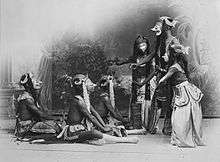
Wayang gedog theatrical performance take themes from the Panji cycles stories from the kingdom of Janggala. The players wear masks known as wayang topeng or wayang gedog. The word gedog comes from kedok, which, like topeng means "mask".
The main story of the performances is of Raden Panji and Candra, a love story about princess Candra Kirana of Kediri and Raden Panji Asmarabangun, the crown prince of Jenggala. Candra Kirana was the incarnation of Dewi Ratih (goddess of love) and Panji was an incarnation of Kamajaya (god of love). Kirana's story was given the title Smaradahana ("The fire of love"). At the end of the complicated story they finally can marry and bring forth a son, named Raja Putra. Panji Asmarabangun ruled Jenggala under the official names Sri Kameswara, Prabu Suryowiseso, and Hino Kertapati. Originally, wayang wong was performed only as an aristocratic entertainment in four palaces of Yogyakarta and Surakarta. In the course of time, it spread to become a popular and folk form as well.
Wayang golek
Wayang golek are three-dimensional wooden rod puppets that are operated from below a wooden rod that runs through the body to the head, and by sticks connected to the hands. The construction of the puppets contributes to their versatility, expressiveness and aptitude for imitating human dance. Today, wayang golek is mainly associated with Sundanese culture of West Java. In Central Java, the wooden wayang also known as Wayang Menak, which originated from Kudus, Central Java.

Little is known for certain about the history of wayang golek, but scholars have speculated that it most likely originated in China and arrived in Java sometime in the 17th century. Some of the oldest traditions of wayang golek are from the north coast of Java in what is called the pasisir region. This is home to some of the oldest Muslim kingdoms in Java and it is likely the wayang golek grew in popularity through telling the wayang menak stories of Amir Hamza, the uncle of Muhammad. These stories are still widely performed in Kabumen, Tegal, and Jepara as wayang golek menak, and in Cirebon, wayang golek cepak. Legendary origins of wayang golek attribute their invention to the Muslim saint Wali Sunan Kudus, who used the medium to proselytize Muslim values.
In the 18th century the tradition moved into the mountainous region of Priangan West Java where it eventually was used to tell stories of the Ramayana and the Mahabharata in a tradition now called Wayang Golek Purwa, which can be found in Bandung, Bogor and Jakarta. The adoption of Javanese Mataram kejawen culture by Sundanese aristocrats was probably the remnant of Mataram influence over the Priangan region during the reign of expansive Sultan Agung. While main characters from Ramayana and Mahabharata are similar with wayang kulit purwa version of Central Java, some of punakawan (servant also jester) were rendered in Sundanese names and characteristics, such as Cepot or Astrajingga as Bagong, Dawala or Udel as Petruk. Wayang golek purwa has become the most popular form of wayang golek today and the most famous puppeteer family is the Sunarya family which has produced several generations of stellar performers.
Wayang karucil or Wayang klitik
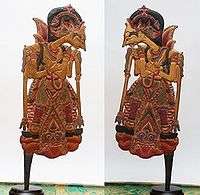
Wayang klitik figures occupy a middle ground between the figures of wayang golek and wayang kulit. They are constructed similarly to wayang kulit figures, but from thin pieces of wood instead of leather, and, like wayang kulit figures, are used as shadow puppets. A further similarity is that they are the same smaller size as wayang kulit figures. However, wood is more subject to breakage than leather. During battle scenes, wayang klitik figures often sustain considerable damage, much to the amusement of the public, but in a country in which before 1970 there were no adequate glues available, breakage generally meant an expensive, newly made figure. On this basis the wayang klitik figures, which are to appear in plays where they have to endure battle scenes, have leather arms. The name of these figures is onomotopaeic, from the sound klitik-klitik, that these figures make when worked by the dalang.
Wayang klitik figures come originally from eastern Java, where one still finds workshops turning them out. They are less costly to produce than wayang kulit figures.
The origin of the stories involved in these puppet plays comes from the kingdoms of eastern Java: Jenggala, Kediri and Majapahit. From Jenggala and Kediri come the stories of Raden Panji and Cindelaras, which tells of the adventures of a pair of village youngsters with their fighting cocks. The Damarwulan presents the stories of a hero from Majapahit. Damarwulan is a clever chap, who with courage, aptitude, intelligence and the assistance of his young lover Anjasmara, makes a surprise attack on the neighboring kingdom and brings down Minakjinggo, an Adipati (viceroy) of Blambangan and mighty enemy of Majapahit's beautiful queen Sri Ratu Kencanawungu. As a reward, Damarwulan is married to Kencanawungu and becomes king of Majapahit; he also takes Lady Anjasmara as a second wife. This story is full of love affairs and battles and is very popular with the public. The dalang is liable to incorporate the latest local gossip and quarrels and work them into the play as comedy.
Wayang beber

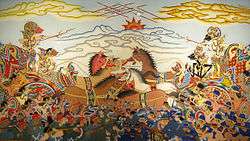
Wayang beber relies on scroll-painted presentations of the stories being told.[25] Wayang beber has strong similarities to narratives in the form of illustrated ballads that were common at annual fairs in medieval and early modern Europe. They have also been subject to the same fate—they have nearly vanished although there are still some groups of artists who support wayang beber in places such as Surakarta (Solo) in Central Java.[26]
Chinese visitors to Java during the 15th century described a storyteller or unrolled scrolls and told stories that made the audience laugh or cry. A few scrolls of images remain from those times, found today in museums. There are two sets, hand-painted on hand-made bark cloth, that are still owned by families who have inherited them from many generations ago, in Pacitan and Wonogiri, both villages in Central Java. Performances, mostly in small open-sided pavilions or auditoriums, take place according to the following pattern:
The dalang gives a sign, the small gamelan orchestra with drummer and a few knobbed gongs and a musician with a rebab (violin-like instrument held vertically) begins to play and the dalang unrolls the first scroll of the story. Then, speaking and singing, he narrates the episode in more detail. In this manner, in the course of the evening he unrolls several scrolls one at a time. Each scene in the scrolls represents a story or part of a story. The content of the story typically stems from the Panji romances which are semi-historical legends set in the 12th-13th century East Javanese kingdoms of Jenggala, Daha and Kediri, and also in Bali.[27]
Wayang and new themes
According to Marzanna Paplawska, the historically popular Wayang kulit typically is based on the Hindu epics the Mahabharata and the Ramayana.[28] In 1960s, the Christian missionary effort adopted the art form to create Wayang wahyu. The Javanese Jesuit Brother Timotheus L. Wignyosubroto used the show to communicate to the Javanese and other Indonesians the teachings of the Bible and of the Catholic Church in a manner accessible to the audience.[28] Similarly, Wayang sadat has deployed Wayang for religious teachings of Islam, while Wayang pancasila has used it as a medium for national politics.[28]
Characters
Wayang characters are derived from several group of stories and settings. The most popular and the most ancient is wayang purwa which its story and characters was derived from Indian Hindu epics of Ramayana and Mahabharata, set in ancient kingdoms of Hastinapura, Ayodhya and Alengkapura (Lanka). Another group of characters derived from Panji cycles, natively developed in Java during Kediri Kingdom, the story set in twin Javanese kingdoms of Janggala and Panjalu (Kediri).
Wayang Purwa
Wayang Purwa (Javanese for "ancient" or "original" wayang) refer to wayang that based on the stories of Hindu epics Ramayana and Mahabharata. Its form of expression usually performed as wayang kulit, wayang golek, and wayang wong dance drama [29].
In Central Java, popular wayang kulit characters include the following (Notopertomo & Jatirahayu 2001).[30]
|
|
|
|
|
Wayang Panji
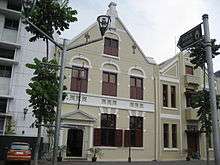
Derived from Panji cycles, natively developed in Java during Kediri Kingdom, the story set in twin Javanese kingdoms of Janggala and Panjalu (Kediri). Its form of expressions are usually performed as wayang gedog (masked wayang) and wayang wong dance drama of Java and Bali.
- Raden Panji, alias Panji Asmoro Bangun, alias Panji Kuda Wanengpati, alias Inu Kertapati
- Galuh Chandra Kirana, alias Sekartaji
- Panji Semirang, alias Kuda Narawangsa, the male disguise of Princess Kirana
- Anggraeni
Wayang Menak

Derived from Javanese-Islamic literature Serat Menak which is a Javanese rendering of Malay Hikayat Amir Hamzah, which ultimately derived from Persian Hamzanama, tell the adventure of Amir Hamzah, the uncle of prophet Muhammad.[31] The wooden wayang Menak is similar in shape to Wayang Golek, it is most prevalent in northern coast of Central Java, especially Kudus area.
- Wong Agung Jayeng Rana / Amir Ambyah / Amir Hamzah
- Prabu Nursewan
- Umar Maya
- Umar Madi
- Dewi Retna Muninggar
Notes
References
- 1 2 3 James R. Brandon (2009). Theatre in Southeast Asia. Harvard University Press. pp. 143–145, 352–353. ISBN 978-0-674-02874-6.
- 1 2 3 4 5 6 7 8 "Wayang: Indonesian Theatre]". Encyclopaedia Britannica. 2012.
- 1 2 3 4 5 6 Don Rubin; Chua Soo Pong; Ravi Chaturvedi; et al. (2001). The World Encyclopedia of Contemporary Theatre: Asia/Pacific. Taylor & Francis. pp. 184–186. ISBN 978-0-415-26087-9.
- 1 2 Miyao, J. (1977). "P. L. Amin Sweeney and Akira Goto (ed.) An International Seminar on the Shadow Plays of Asia". Southeast Asia: History and Culture. Japan Society for Southeast Asian Studies (7): 142–146. doi:10.5512/sea.1977.142.
- 1 2 3 Yves Bonnefoy (1993). Asian Mythologies. University of Chicago Press. p. 162. ISBN 978-0-226-06456-7.
- ↑ Siyuan Liu (2016). Routledge Handbook of Asian Theatre. Routledge. pp. 72–81. ISBN 978-1-317-27886-3.
- ↑ ""Wayang puppet theatre", Inscribed in 2008 (3.COM) on the Representative List of the Intangible Cultural Heritage of Humanity (originally proclaimed in 2003)". UNESCO. Retrieved 10 October 2014.
- ↑ Beth Osnes (2010). The Shadow Puppet Theatre of Malaysia: A Study of Wayang Kulit with Performance Scripts and Puppet Designs. McFarland. pp. 2–3, 7–14. ISBN 978-0-7864-5792-2.
- ↑ Thai Shadow Puppet Show Archived 2017-11-07 at the Wayback Machine., Museum of Anthropology, University of Missouri (2015)
- ↑ Siyuan Liu (2016). Routledge Handbook of Asian Theatre. Routledge. pp. 194, 553, 561. ISBN 978-1-317-27886-3.
- ↑ Mair, Victor H. Painting and Performance: Picture Recitation and Its Indian Genesis. Honolulu: University of Hawaii Press, 1988. p. 58.
- 1 2 3 4 5 6 James R. Brandon (2009). Theatre in Southeast Asia. Harvard University Press. pp. 42–44, 65, 92–94, 278. ISBN 978-0-674-02874-6.
- ↑ Kathy Foley (2016). Siyuan Liu, ed. Routledge Handbook of Asian Theatre. Routledge. pp. 181–182. ISBN 978-1-317-27886-3.
- ↑ Kathy Foley (2016). Siyuan Liu, ed. Routledge Handbook of Asian Theatre. Routledge. pp. 182–184. ISBN 978-1-317-27886-3.
- ↑ Varadpande, Manohar Laxman (1987). History of Indian Theatre, Volume 1. New Delhi: Abhinav Publications. p. 75. ISBN 9788170172215.
- ↑ Drs. R. Soekmono, (1973). Pengantar Sejarah Kebudayaan Indonesia 2, 2nd ed. 5th reprint edition in 1988. Yogyakarta: Penerbit Kanisius. p. 56.
- ↑ Sedana, I Nyoman; Foley, Kathy (1993). "The Education of a Balinese Dalang". Asian Theatre Journal. University of Hawaii Press. 10 (1): 81–100. doi:10.2307/1124218.
- 1 2 Siyuan Liu (2016). Routledge Handbook of Asian Theatre. Routledge. pp. 166, 175 note 2, 76–78. ISBN 978-1-317-27886-3.
- ↑ Sumarsam (15 December 1995). Gamelan: Cultural Interaction and Musical Development in Central Java. University of Chicago Press. p. 30. ISBN 978-0-226-78011-5. Retrieved 19 June 2012.
- ↑ Eckersley. M.(ed.) 2009. Drama from the Rim: Asian Pacific Drama Book. Drama Victoria. Melbourne. 2009. (p15)
- ↑ Wayang grupo Indra Swara, Mexico City, December 1, 2016
- ↑ Simon Sudarman, 'Sagio: Striving to preserve wayang', The Jakarta Post, 11 September 2012.
- ↑ James R. Brandon (2009). Theatre in Southeast Asia. Harvard University Press. pp. 46–54, 143–144, 150–152. ISBN 978-0-674-02874-6.
- ↑ Indra Swara Festejo dia de niños, Mexico City, May 1, 2017, p. Cultura
- ↑ Ganug Nugroho Adil, 'Joko Sri Yono: Preserving "wayang beber"', The Jakarta Post, 27 March 2012.
- ↑ Ganug Nugroho Adil, 'The metamorphosis of "Wayang Beber"', The Jakarta Post, 19 April 2013.
- ↑ Ganug Nugroho Adil, 'Sinhanto: A wayang master craftsman', The Jakarta Post 22 June 2012.
- 1 2 3 Poplawska, Marzanna (2004). "Wayang Wahyu as an Example of Christian Forms of Shadow Theatre". Asian Theatre Journal. Johns Hopkins University Press. 21 (2): 194–202. doi:10.1353/atj.2004.0024.
- ↑ Inna Solomonik. Wayang Purwa Puppets: the Language of the Silhouette - in: “Bijdragen tot de Taal-, Land- en Volkenkunde”, 136 (1980), no: 4, Leiden, hlm. 482-497
- ↑ Notopertomo, Margono; Warih Jatirahayu. 2001. 51 Karakter Tokoh Wayang Populer. Klaten, Indonesia: Hafamina. ISBN 979-26-7496-9
- ↑ "Amir Hamzah, uncle of the Prophet Muhammad, spreader of Islam, and hero of the Serat Menak". Asian Art Education.
- Signell, Karl. Shadow Music of Java. 1996 Rounder Records CD #5060, Cambridge MA.
- This article was initially translated from the German-language Wikipedia article.
- Poplawska, Marzanna. Asian Theatre Journal. Fall 2004, Vol. 21 p. 194-202
Further reading
- Alton L. Becker (1979), Aram Yengoyan and Alton L. Becker, ed., Text-Building, Epistemology, and Aesthetics in the Javanese Shadow Theatre, Norwood, NJ: ABLEX
- Brandon, James (1970) On Thrones of Gold — Three Javanese Shadow Plays. Harvard.
- Ghulam-Sarwar Yousof. (1994)Dictionary of Traditional South-East Asian Theatre. Oxford University Press.
- Clara van Groenendael, Victoria (1985) The Dalang Behind the Wayang. Dordrecht, Foris
- Keeler, Ward (1987) Javanese Shadow Plays, Javanese Selves. Princeton University Press
- Keeler, Ward (1992) Javanese Shadow Puppets. OUP
- Long, Roger (1982) Javanese shadow theatre: Movement and characterization in Ngayogyakarta wayang kulit. Umi Research Press
- Mellema, R.L. (1988) Wayang Puppets: Carving, Colouring, Symbolism. Amsterdam, Royal Tropical Institute, Bulletin 315.
- Mudjanattistomo (1976) Pedhalangan Ngayogyakarta. Yogyakarta (in Javanese)
- Signell, Karl (1996) Shadow Music of Java. CD booklet. Rounder Records CD 5060
- Soedarsono (1984) Wayang Wong. Yogyakarta, Gadjah Mada University Press
External links
| Wikimedia Commons has media related to Wayang. |
- Historical Development of Puppetry: Scenic Shades (includes information about wayang beber, kulit, klitik and golek)
- Seleh Notes article on identifying Central Javanese wayang kulit
- Wayang Orang (wayang wong) traditional dance, from Indonesia Tourism
- Wayang Klitik: a permanent exhibit of Puppetry Arts Museum
- Wayang Golek Photo Gallery, includes description, history and photographs of individual puppets by Walter O. Koenig
- Wayang Kulit: The Art form of the Balinese Shadow Play by Lisa Gold
- Wayang Puppet Theatre on the Indonesian site of UNESCO
- The Wayang Golek Wooden Stick Puppets of Java, Indonesia (commercial site)
- An overview of the Shadow Puppets tradition (with many pictures) in a site to Discover Indonesia
- Wayang Kulit exhibition at the Museum of International Folk Art
- Wayang Kulit Collection of Shadow Puppets, Simon Fraser University Museum of Archaeology & Ethnology digitized on Multicultural Canada website
- Contemporary Wayang Archive, by the National University of Singapore
- Wayang Kontemporer, an interactive PhD dissertation on Contemporary Wayang Archive
